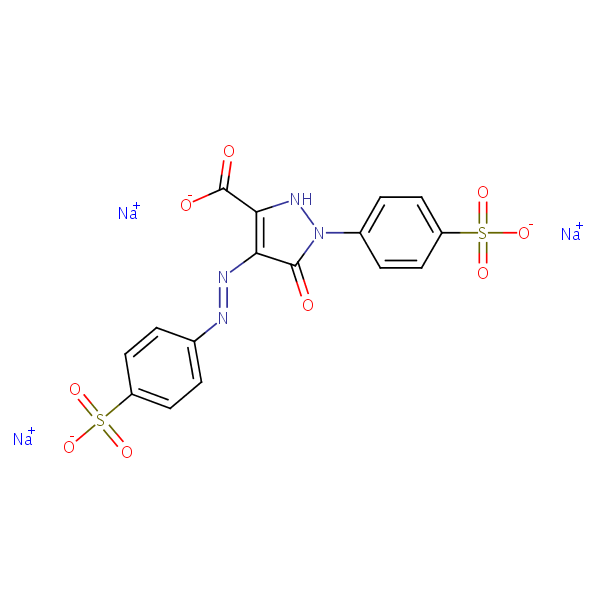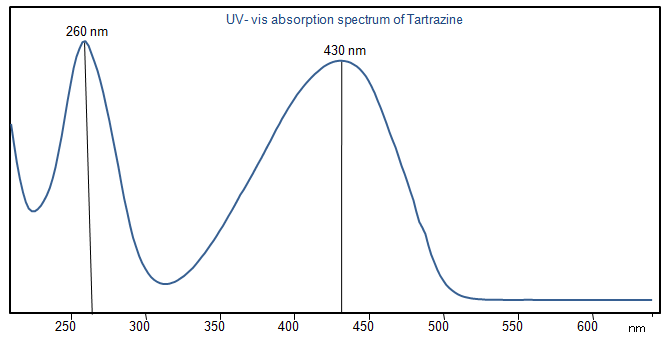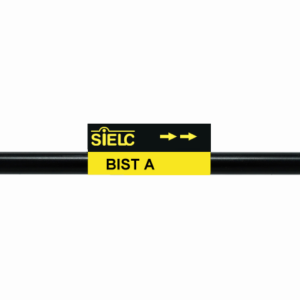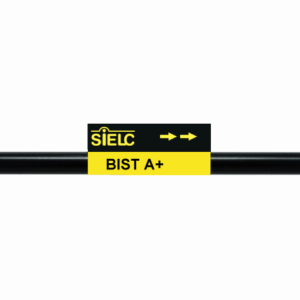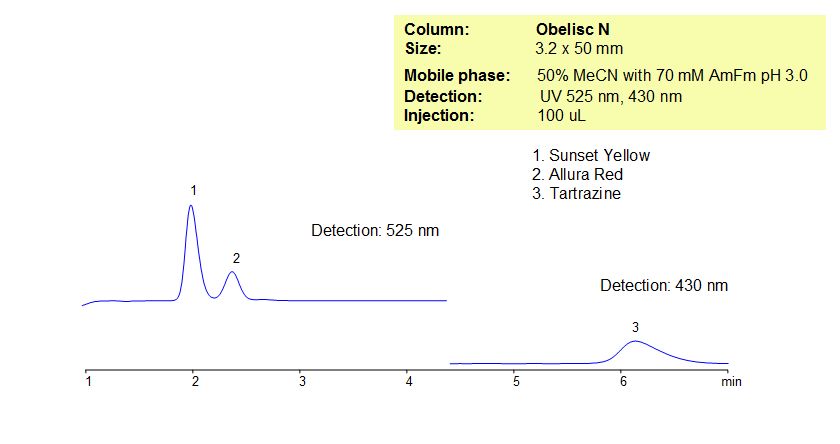| CAS Number | 1934-21-0 |
|---|---|
| Molecular Formula | C16H9N4Na3O9S2 |
| Molecular Weight | 534.360 |
| InChI Key | ZLWLTDZLUVBSRJ-GLCFPVLVSA-K |
| LogP | -0.479 |
| Synonyms |
|
Applications:
HPLC Method for Analysis of FD&C Yellow 5 (Tartrazine) on BIST A and BIST A+ Columns
March 21, 2023
Separation type: Bridge Ion Separation Technology, or BIST™ by SIELC Technologies
HPLC Method for Analysis of Tartrazine (FD&C Yellow 5) on BIST A and BIST A+ Columns by SIELC Technologies
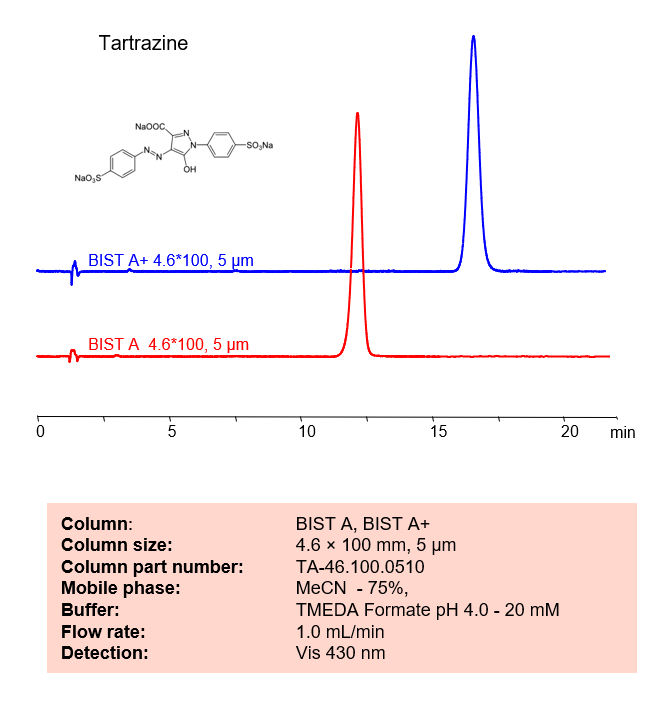
High Performance Liquid Chromatography (HPLC) Method for Analysis of Tartrazine (FD&C Yellow 5)
Tartrazine is a popular, multi-charged yellow synthetic dye used in a multitude of food and cosmetic products, including colorful sugar-coated chocolate candies. Using SIELC’s newly introduced BIST™ method, tartrazine, which dissolves and ionizes in water, can be retained on a negatively-charged, cation-exchange BIST™ A+ column. There are two keys to this retention method: 1) a multi-charged, positive buffer, such as Magnesium acetate (Mg(AcO)2), which acts as a bridge, linking the negatively charged dye to the negatively-charged column surface and 2) a mobile phase consisting mostly of organic solvent (such as MeCN) to minimize the formation of a solvation layer around the charged analytes. Using this new and unique analysis method, Tartrazine can be separated, retained, and UV detected at 430 nm.
To extract the dye from the candy, place a colored sugar-coated chocolate candy in a beaker filled with about 20 mL of water. Once the dye is dissolved into the water, fill a syringe with the water and then place a filter at the end of the syringe. Depress the plunger and fill a new clean vial with the extracted dye. The Tartrazine is now ready to be analyzed.
Condition
| Column | BIST A, 4.6 x 100 mm, 5 µm, 100 A, dual ended |
| Mobile Phase | MeCN – 75% |
| Buffer | TMEDA Formate pH 4.0 – 20 mM |
| Flow Rate | 0.5 ml/min |
| Detection | Vis 430 nm |
Description
| Class of Compounds | Acid, Dye |
| Analyzing Compounds | Tartrazine (FD&C Yellow 5) |
Application Column
BIST A
Column Diameter: 4.6 mm
Column Length: 100 mm
Particle Size: 5 µm
Pore Size: 100 A
Column options: dual ended
BIST A+
Column Diameter: 4.6 mm
Column Length: 100 mm
Particle Size: 5 µm
Pore Size: 100 A
Column options: dual ended

HPLC Method for Analysis of FD&C Yellow 5 (Tartrazine) in M&M’s on BIST A+ Column
February 16, 2023
Separation type: Bridge Ion Separation Technology, or BIST™ by SIELC Technologies
HPLC Method for Analysis of Tartrazine (FD&C Yellow 5) on BIST A+ by SIELC Technologies
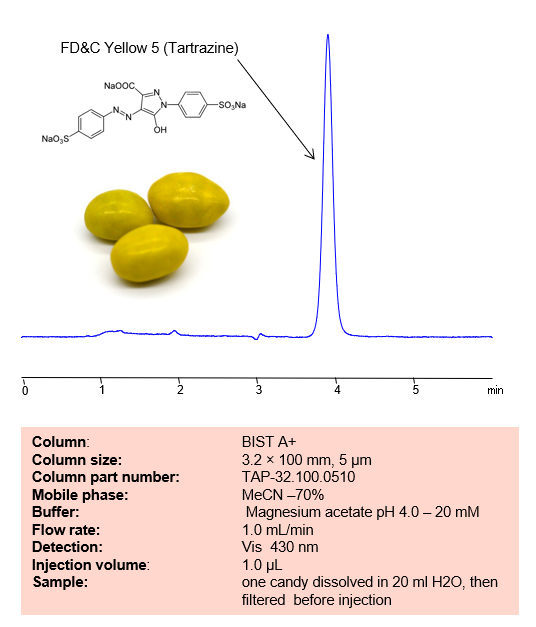
High Performance Liquid Chromatography (HPLC) Method for Analysis of Tartrazine (FD&C Yellow 5)
Tartrazine is a popular, multi-charged yellow synthetic dye used in a multitude of food and cosmetic products, including colorful sugar-coated chocolate candies. Using SIELC’s newly introduced BIST™ method, tartrazine, which dissolves and ionizes in water, can be retained on a negatively-charged, cation-exchange BIST™ A+ column. There are two keys to this retention method: 1) a multi-charged, positive buffer, such as Magnesium acetate (Mg(AcO)2), which acts as a bridge, linking the negatively charged dye to the negatively-charged column surface and 2) a mobile phase consisting mostly of organic solvent (such as MeCN) to minimize the formation of a solvation layer around the charged analytes. Using this new and unique analysis method, Tartrazine can be separated, retained, and UV detected at 430 nm.
To extract the dye from the candy, place a colored sugar-coated chocolate candy in a beaker filled with about 20 mL of water. Once the dye is dissolved into the water, fill a syringe with the water and then place a filter at the end of the syringe. Depress the plunger and fill a new clean vial with the extracted dye. The Tartrazine is now ready to be analyzed.
Condition
| Column | BIST A+, 3.2 x 100 mm, 5 µm, 100 A, dual ended |
| Mobile Phase | MeCN – 70% |
| Buffer | Magnesium Acetate pH 4.0 – 20 mM |
| Flow Rate | 0.5 ml/min |
| Detection | Vis 430 nm |
Description
| Class of Compounds | Acid, Dye |
| Analyzing Compounds | Tartrazine (FD&C Yellow 5) |
Application Column
BIST A+
Column Diameter: 3.2 mm
Column Length: 100 mm
Particle Size: 5 µm
Pore Size: 100 A
Column options: dual ended

HPLC Method for Analysis of Tartrazine on BIST A Column
December 1, 2022
Separation type: Bridge Ion Separation Technology, or BIST™ by SIELC Technologies
HPLC Method for Analysis of Tartrazine on BIST A Column by SIELC Technologies

High Performance Liquid Chromatography (HPLC) Method for Analysis of Tartrazine
Tartrazine is a popular yellow synthetic dye used in a multitude of food and cosmetic products. Using SIELC’s newly introduced BIST™ method, tartrazine, which ionizes in water, can be retained on a negatively-charged, cation-exchange BIST™ A column. There are two keys to this retention method: 1) a multi-charged, positive buffer, such as N,N,N’,N’-Tetramethyl-1,3-propanediamine (TMDAP), which acts as a bridge, linking the negatively-charged tartrazine analytes to the negatively-charged column surface and 2) a mobile phase consisting mostly of organic solvent (such as MeCN) to minimize the formation of a solvation layer around the charged analytes. The effect of reducing the solvation layer by increasing the organic component concentration in the mobile phase can be clearly seen above, as can the effect of multi- and singly-charged buffers on retention. Other positively-charged buffers that can generate BIST™ include Calcium acetate and Magnesium acetate. Using this new and unique analysis method, tartrazine can be retained and UV detected at 260 nm.
Condition
| Column | BIST™ A, 4.6×150 mm, 5 µm, 100A |
| Mobile Phase | MeCN |
| Buffer | TMDAP formate pH 4.0 – 5,0 mM |
| Flow Rate | 1.0 ml/min |
| Detection | 260 nm |
Description
| Class of Compounds | Acid, Dye |
| Analyzing Compounds | Tartrazine |
Application Column
BIST A
BIST™ columns offer a unique and effective way to achieve separations that were traditionally challenging or even impossible with other HPLC columns. With the use of a special mobile phase, these ion exchange columns provide very strong retention for analytes with the same charge polarity as the stationary phase, unlocking new chromatography applications. What makes BIST™ columns stand out is their proprietary surface chemistry, which results in superior selectivity, resolution, and sensitivity. These columns offer a simple, efficient solution for a variety of analytical challenges, making them an excellent choice for researchers and analysts across many different fields. To learn more about the technology that powers BIST™ columns and to explore related applications, check out https://BIST.LC.
Select options
HPLC Method for Analysis of Brilliant Blue FCF Tartrazine, Sunset Yellow FCF and Allura Red in Monster Energy Drinks on Newcrom BH Column
July 14, 2020
Separation type: Liquid Chromatography Mixed-mode
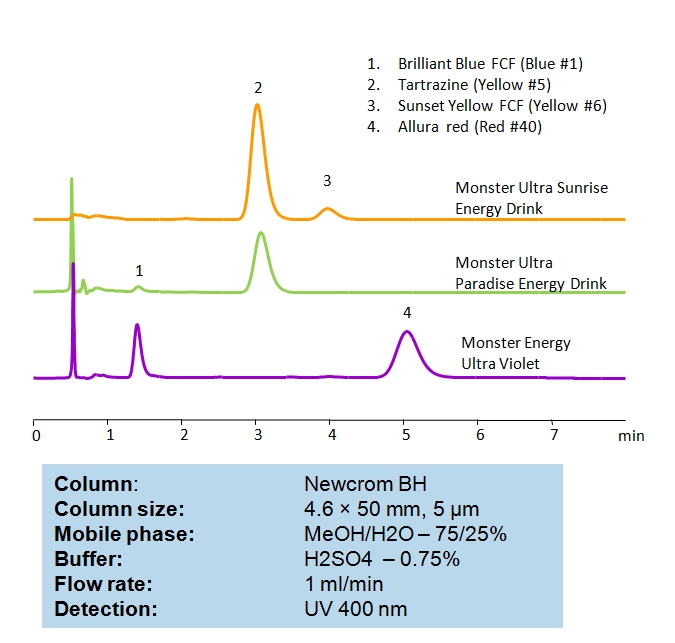
Brilliant Blue FCF, also known as Blue 1, is an compound classified as a triarylmethane dye. Dry, it has the appearance of a light-blue powder, but when dissolved in water, turns deeper blue. Allura Red AC, also known as FD&C Red No. 40, is a red azo dye that is the most commonly used red dye in the United States. It is used anywhere from tattoos to children’s’ medications to drinks and food. If used in food it also has the E number E129. Allura red is sold as a dark red sodium salt, but when dissolved in water, the solution appears orange-red.Sunset Yellow FCF, also known as Orange Yellow S, C.I. 15985, or Yellow 6, is a petroleum-derived orange azo dye. When in powder form, it is Reddish-orange, but when dissolved in water, the liquid becomes bright yellow.The dye is banned or restricted in Norway, Finland and Sweden.
Tartrazine is a yellow food coloring agent. It’s a trisodium salt, and like many multi-charged molecules tends to exhibit significant tailing using reverse-phase HPLC columns. By using a mixed-mode column, specifically designed in mind for multiple charges, Newcrom BH can retain and separate dyes with perfect peak shape using a mobile phase of methanol (MeOH) and water with sulfuric acid (H2SO4) to facilitate ion-exchange. UV detection at 400nm.
High Performance Liquid Chromatography (HPLC) Method for Analysis of Brilliant Blue FCF, Tartrazine, Sunset Yellow FCF and Allura Red
| Column | Newcom BH, 4.6×50 mm, 5 µm, 100A |
| Mobile Phase | MeOH/H2O – 75/25% |
| Buffer | H2SO4 – 0.75% |
| Flow Rate | 1.0 ml/min |
| Detection | UV 400 nm |
| Class of Compounds | Acid, Dyes |
| Analyzing Compounds | Brilliant Blue FCF, Allura Red, Tartrazine, Sunset Yellow FCF |
Application Column
Newcrom BH
The Newcrom columns are a family of reverse-phase-based columns. Newcrom A, AH, B, and BH are all mixed-mode columns with either positive or negative ion-pairing groups attached to either short (25 Å) or long (100 Å) ligand chains. Newcrom R1 is a special reverse-phase column with low silanol activity.
Select optionsBrilliant Blue FCF (Blue 1)
Sunset Yellow (Yellow 6)
Tartrazine (FD&C Yellow 5)

HPLC Determination of Tartrazine (Yellow 5) on Newcrom BH Column
July 1, 2020
Separation type: Liquid Chromatography Mixed-mode
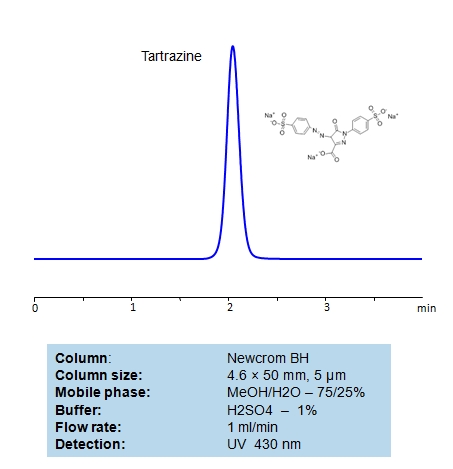
Tartrazine is a yellow food coloring agent. It’s a trisodium salt, and like many multi-charged molecules tends to exhibit significant tailing using reverse-phase HPLC columns. By using a mixed-mode column, specifically designed in mind for multiple charges, Newcrom BH can retain tartrazine with perfect peak shape using a mobile phase of methanol (MeOH) and water with sulfuric acid (H2SO4) to facilitate ion-exchange. UV detection at 430nm.
High Performance Liquid Chromatography (HPLC) Method for Analysis of Tartrazine
| Column | Newcrom BH, 4.6×50 mm, 5 µm, 100A |
| Mobile Phase | MeOH/H2O – 75/25% |
| Buffer | H2SO4 – 1% |
| Flow Rate | 1.0 ml/min |
| Detection | UV 430 nm |
| Class of Compounds | Acid, Dyes |
| Analyzing Compounds | Tartrazine Yellow 5 |
Application Column
Newcrom BH
The Newcrom columns are a family of reverse-phase-based columns. Newcrom A, AH, B, and BH are all mixed-mode columns with either positive or negative ion-pairing groups attached to either short (25 Å) or long (100 Å) ligand chains. Newcrom R1 is a special reverse-phase column with low silanol activity.
Select options
HPLC Method for Analysis of Allura Red, Sunset Yellow, Tartrazine in Mountain Dew Live Wire at 2 Wavelengths
March 29, 2017
Sunset Yellow FCF, also known as Orange Yellow S, C.I. 15985, or Yellow 6, is a petroleum-derived orange azo dye. When in powder form, it is Reddish-orange, but when dissolved in water, the liquid becomes bright yellow. The dye is banned or restricted in Norway, Finland and Sweden. Obelisc N is a column with very polar characteristics. It contains embedded acidic and basic ionizable groups and can retain Sunset Yellow. The method is LC/MS and UV compatible and can be used as a general approach for analyzing similar compounds.
| Column | Obelisc N, 3.2×50 mm, 5 µm, 100A |
| Mobile Phase | MeCN/H2O – 50/50% |
| Buffer | AmFm pH 3.0 – 70 mM |
| Flow Rate | 0.6 ml/min |
| Detection | UV, 430, 525 nm |
| Class of Compounds |
Dye, Acid, Hydrophilic, Ionizable, Zwitterionic |
| Analyzing Compounds | Allura Red, Sunset Yellow, Tartrazine |
Application Column
Obelisc N
SIELC has developed the Obelisc™ columns, which are mixed-mode and utilize Liquid Separation Cell technology (LiSC™). These cost-effective columns are the first of their kind to be commercially available and can replace multiple HPLC columns, including reversed-phase (RP), AQ-type reversed-phase, polar-embedded group RP columns, normal-phase, cation-exchange, anion-exchange, ion-exclusion, and HILIC (Hydrophilic Interaction Liquid Chromatography) columns. By controlling just three orthogonal method parameters - buffer concentration, buffer pH, and organic modifier concentration - users can adjust the column properties with pinpoint precision to separate complex mixtures.
Select optionsHPLC Method for Analysis of Allura Red in Children’s Mucinex Multi-Syptom Cold
HPLC Method for Analysis of Allura Red in Robitussin Cough & Cold
HPLC Method for Analysis of Allura Red in Soft Drinks 2
HPLC Method for Analysis of Allura Red in Soft Drinks 3
HPLC Method for Analysis of Allura Red in Soft Drinks 4
HPLC Method for Analysis of Allura Red in Soft Drinks 5
HPLC Method for Analysis of Allura Red, Sunset Yellow, Tartrazine in Mountain Dew Live Wire at 1 Wavelength
HPLC Method for Analysis of Brilliant Blue and Allura Red in Children’s Mucinex Night Time Multi-Symptom Cold
Sunset Yellow (Yellow 6)
Tartrazine (FD&C Yellow 5)

